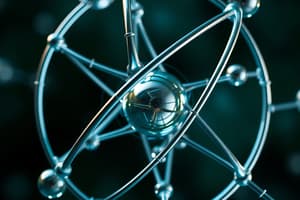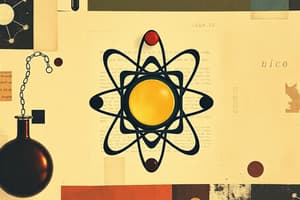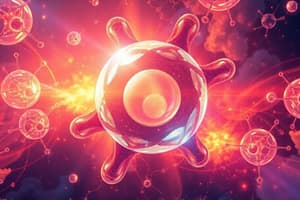Podcast
Questions and Answers
What is the overall equation for photosynthesis?
What is the overall equation for photosynthesis?
- 6H2O + C6H12O6 → 6O2 + 6CO2
- C6H12O6 + 6O2 → 6CO2 + 6H2O
- 6CO2 + 6O2 → 6H2O + C6H12O6
- 6CO2 + 6H2O → C6H12O6 + 6O2 (correct)
Which property of water allows it to support life by maintaining temperature?
Which property of water allows it to support life by maintaining temperature?
- Solvency
- High heat of vaporization
- High heat capacity (correct)
- High surface tension
What type of bond forms between the oxygen atom of one water molecule and the hydrogen atom of another?
What type of bond forms between the oxygen atom of one water molecule and the hydrogen atom of another?
- Nonpolar covalent bond
- Hydrogen bond (correct)
- Ionic bond
- Polar covalent bond
What percentage of water content is typically found in all organisms?
What percentage of water content is typically found in all organisms?
Which of the following is NOT a property of water?
Which of the following is NOT a property of water?
What causes the atoms in a water molecule to share their electrons unequally?
What causes the atoms in a water molecule to share their electrons unequally?
Which property of water is responsible for its ability to dissolve many substances?
Which property of water is responsible for its ability to dissolve many substances?
What phenomenon allows water to form from hydrogen bonds?
What phenomenon allows water to form from hydrogen bonds?
What is the maximum number of electrons that can occupy the second electron shell of an atom?
What is the maximum number of electrons that can occupy the second electron shell of an atom?
Carbon-14 dating can determine the age of organic materials up to approximately how many years?
Carbon-14 dating can determine the age of organic materials up to approximately how many years?
What happens to carbon-14 in an organism after it dies?
What happens to carbon-14 in an organism after it dies?
Which of the following correctly describes valence in an atom?
Which of the following correctly describes valence in an atom?
The octet rule states that atoms are most stable when they have how many electrons in their outer shell?
The octet rule states that atoms are most stable when they have how many electrons in their outer shell?
What do orbitals represent in an atom?
What do orbitals represent in an atom?
In atoms with more than two shells, what is the primary factor affecting the stability of the outer shell?
In atoms with more than two shells, what is the primary factor affecting the stability of the outer shell?
Which of the following statements about chemical properties of atoms is correct?
Which of the following statements about chemical properties of atoms is correct?
What property of water allows it to dissolve many substances?
What property of water allows it to dissolve many substances?
Which type of molecules are attracted to water?
Which type of molecules are attracted to water?
How does water's adhesion property assist in nature?
How does water's adhesion property assist in nature?
What occurs when NaCl is dissolved in water?
What occurs when NaCl is dissolved in water?
What contributes to the high surface tension of water?
What contributes to the high surface tension of water?
Which property of water explains why it moves up a tree from the roots to the leaves?
Which property of water explains why it moves up a tree from the roots to the leaves?
Hydrophobic molecules are characterized by their ability to:
Hydrophobic molecules are characterized by their ability to:
What is the general process by which molecules separate into ions, atoms, or radicals called?
What is the general process by which molecules separate into ions, atoms, or radicals called?
What property of water allows it to absorb heat without significantly changing temperature?
What property of water allows it to absorb heat without significantly changing temperature?
What happens to the temperature of water when it absorbs heat?
What happens to the temperature of water when it absorbs heat?
Why does ice float on water?
Why does ice float on water?
What energy change occurs as water evaporates?
What energy change occurs as water evaporates?
What role does ice play in aquatic environments?
What role does ice play in aquatic environments?
What is the primary function of buffers in the body?
What is the primary function of buffers in the body?
What is the normal pH range of blood in a healthy individual?
What is the normal pH range of blood in a healthy individual?
What condition can result from the body's inability to buffer excess H+ ions?
What condition can result from the body's inability to buffer excess H+ ions?
Which disease is associated with an increased risk of acidosis due to buffering failure?
Which disease is associated with an increased risk of acidosis due to buffering failure?
What can ultimately happen if acidosis is left untreated?
What can ultimately happen if acidosis is left untreated?
What ions are produced when water dissociates?
What ions are produced when water dissociates?
Which solution is considered acidic based on pH?
Which solution is considered acidic based on pH?
Which of the following acids releases hydrogen ions when dissolved?
Which of the following acids releases hydrogen ions when dissolved?
A solution with a pH of 6 is classified as what?
A solution with a pH of 6 is classified as what?
What happens to the concentration of hydroxide ions in a basic solution?
What happens to the concentration of hydroxide ions in a basic solution?
Which of the following describes the pH scale?
Which of the following describes the pH scale?
Which solution is classified as basic?
Which solution is classified as basic?
What does a pH of 7 indicate about a solution?
What does a pH of 7 indicate about a solution?
Flashcards
Carbon-14 Dating
Carbon-14 Dating
A method to estimate the age of organic material up to about 60,000 years old by measuring the remaining carbon-14 atoms.
Carbon-14
Carbon-14
A radioactive form of carbon that's absorbed by living things and decays over time.
Electron Shells
Electron Shells
Energy levels where electrons orbit the atom's nucleus.
Electron Orbitals
Electron Orbitals
Signup and view all the flashcards
Octet Rule
Octet Rule
Signup and view all the flashcards
Valence Shell
Valence Shell
Signup and view all the flashcards
Valence
Valence
Signup and view all the flashcards
Electron arrangement
Electron arrangement
Signup and view all the flashcards
Photosynthesis equation
Photosynthesis equation
Signup and view all the flashcards
Glucose
Glucose
Signup and view all the flashcards
Water's importance to life
Water's importance to life
Signup and view all the flashcards
Polar covalent bond (water)
Polar covalent bond (water)
Signup and view all the flashcards
Hydrogen bond (water)
Hydrogen bond (water)
Signup and view all the flashcards
Water's solvent property
Water's solvent property
Signup and view all the flashcards
Water's cohesion
Water's cohesion
Signup and view all the flashcards
Water's high heat capacity
Water's high heat capacity
Signup and view all the flashcards
Solvent
Solvent
Signup and view all the flashcards
Hydrophilic
Hydrophilic
Signup and view all the flashcards
Hydrophobic
Hydrophobic
Signup and view all the flashcards
Dissociation
Dissociation
Signup and view all the flashcards
Cohesion
Cohesion
Signup and view all the flashcards
Adhesion
Adhesion
Signup and view all the flashcards
Surface tension
Surface tension
Signup and view all the flashcards
Water as a transport system
Water as a transport system
Signup and view all the flashcards
High heat capacity of water
High heat capacity of water
Signup and view all the flashcards
High heat of vaporization
High heat of vaporization
Signup and view all the flashcards
Ice less dense than water
Ice less dense than water
Signup and view all the flashcards
Water's expansion on freezing
Water's expansion on freezing
Signup and view all the flashcards
Ice insulation in water
Ice insulation in water
Signup and view all the flashcards
Water Dissociation
Water Dissociation
Signup and view all the flashcards
Acidic Solution
Acidic Solution
Signup and view all the flashcards
Basic Solution
Basic Solution
Signup and view all the flashcards
pH Scale
pH Scale
Signup and view all the flashcards
What does pH measure?
What does pH measure?
Signup and view all the flashcards
What is the pH of a neutral solution?
What is the pH of a neutral solution?
Signup and view all the flashcards
Acidic vs. Basic
Acidic vs. Basic
Signup and view all the flashcards
pH and H+ Concentration
pH and H+ Concentration
Signup and view all the flashcards
What are buffers?
What are buffers?
Signup and view all the flashcards
How does pH relate to blood?
How does pH relate to blood?
Signup and view all the flashcards
What is acidosis?
What is acidosis?
Signup and view all the flashcards
How can acidosis be caused?
How can acidosis be caused?
Signup and view all the flashcards
What are the potential consequences of acidosis?
What are the potential consequences of acidosis?
Signup and view all the flashcards
Study Notes
Matter and Atoms
- Matter is anything that occupies space and has mass.
- Matter exists as solids, liquids, gases, or plasma.
- Matter is composed of elements.
- An element cannot be broken down into other substances by ordinary chemical means.
- Only 92 elements occur naturally.
- Four elements—carbon, hydrogen, oxygen, and nitrogen—make up about 96% of the body weight of most living organisms.
Where Elements Come From
- Normal chemical reactions do not produce elements.
- Heavier elements, like iron, are created in supernova explosions.
- Supernova explosions scatter heavier elements into space, which then become parts of planets.
Atomic Structure 1
- Atoms are the basic units of elements.
- Atoms cannot be subdivided into smaller substances without losing their properties.
- Atoms are composed of subatomic particles:
- Protons (positively charged)
- Neutrons (no charge)
- Electrons (negatively charged)
- Protons and neutrons are found in the nucleus.
- Electrons are found outside the nucleus in orbitals.
Atomic Structure 2
- Atomic symbol: represents the atom/element
- Examples: H (hydrogen), Na (sodium)
- Mass number: sum of protons and neutrons (electrons have negligible mass)
Atomic Number
- All atoms of an element have the same number of protons.
- The atomic number equals the number of protons and electrons in a neutral atom.
Periodic Table
- Elements' chemical and physical characteristics recur in a predictable manner.
- Elements are arranged in periods (rows) and groups (columns) in the periodic table.
Isotopes
- Atoms of the same element can differ in the number of neutrons.
- Isotopes have the same number of protons but different numbers of neutrons (and thus different mass numbers).
- Some isotopes are unstable and decay, emitting radiation.
- Radioactive isotopes behave very similarly to stable isotopes, but can be used as tracers or to sterilize equipment.
Arrangement of Electrons in an Atom
- Electrons are constantly moving.
- Electron shells are useful for models of atoms with energy levels.
- Each shell contains a certain number of electrons.
- Orbitals are pathways in which electrons rotate around the nucleus.
Bonds and Molecules
- Molecules result from combinations of two or more atoms.
- Compounds are molecules composed of two or more different elements.
- Atoms can share, donate, or accept electrons to form chemical bonds.
Types of Chemical Bonds
- Chemical bonds form when two or more atoms share, donate, or accept electrons.
- Ionic bonds: result from electron transfers between atoms, forming ions with opposite charges.
- Covalent bonds: result from electron sharing between atoms to complete their outer electron shells.
- Hydrogen bonds: occur when a hydrogen atom attracted to electronegative atoms (like oxygen or nitrogen).
Chemical Formulas and Reactions
- Chemical formulas show the elements and the relative number of atoms in a compound.
- Balanced chemical equations have the same number of each type of atom on both sides.
- Reactants are substances that participate in a chemical reaction.
- Products are the substances produced by a chemical reaction.
Water's Importance to Life
- Life began in water.
- Water is the most important molecule on Earth, making up 70-90% of most organisms.
- Water's properties (solvency, cohesion, adhesion, high surface tension, high heat capacity, high heat of vaporization, and varying density) are crucial for life.
Acids and Bases
- Water dissociates into hydrogen ions (H⁺) and hydroxide ions (OH⁻).
- Acidic solutions have a high concentration of H⁺ ions, while basic solutions have a low concentration of them and a high concentration of OH⁻.
- The pH scale measures the concentration of H⁺ ions in a solution.
- Buffers are substances that maintain a relatively stable pH.
pH and pH Scale
- pH is the scale used to measure hydrogen ion concentration.
- The pH scale ranges from 0 to 14, with 7 being neutral.
- An acidic solution has a low pH, while an alkaline (basic) solution has a high pH.
Buffers and pH
- Buffers resist changes in pH by absorbing or releasing H+ or OH- ions.
- The human body uses buffers to maintain a relatively constant blood pH.
Studying That Suits You
Use AI to generate personalized quizzes and flashcards to suit your learning preferences.




